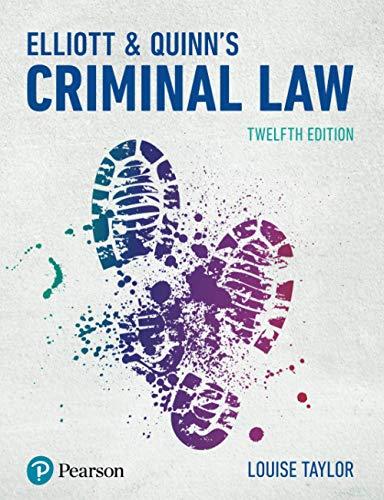Question
Instructions: Step One: Locate the syllogisms in the following excerpts from three famous United States Supreme Court decisions. The Background Excerpt is only
Instructions:
Step One: Locate the syllogisms in the following excerpts from three famous United States Supreme Court decisions. The "Background Excerpt" is only to aid in your general understanding of the case. To identify the syllogism in each case, focus only on the "Excerpt from the Court's Decision.
Step Two: Put each of the syllogisms into standard form: State the major premise, the minor premise, and the conclusion. Note: They may not appear in the appropriate order in the decision. Fill in the missing premise or conclusion if it is an enthymeme.
Brown v. Board of Education
347 U.S. 483 (1954)
Background excerpt: [T]here are findings below that the Negro and white schools involved have been equalized, or are being equalized, with respect to buildings, curricula, qualifications and salaries of teachers, and other "tangible" factors.Our decision, therefore, cannot turn on merely acomparison of these tangible factorsin the Negro and white schools involved in each of the cases. We must look instead to the effect of segregation itself on public education.
In approaching this problem, we cannot turn the clock back to 1868 when the Amendment was adopted, or even to 1896 whenPlessyv.Fergusonwas written. We must consider public education in the light of its full development and its present place in American life throughoutthe Nation. Only in this way can it be determined if segregation in public schools deprives these plaintiffs of the equal protection of the laws.
We come then to the question presented: Doessegregation of children in public schools solely on the basis of race, even though the physical facilities and other "tangible" factors may be equal, deprive the children of the minority group of equal educational opportunities? We believe that it does.
Excerpt from the Court's Decision: We conclude that in the field of public education the doctrine of "separate but equal" has no place. Separate educational facilities are inherently unequal. Therefore, we hold that the plaintiffs and others similarly situated for whom the actions have been brought are, by reason of the segregation complained of, deprived of the equal protection of the laws guaranteed [under the Constitution].
Syllogism:
Major Premise:
Minor Premise:
Conclusion:
Step by Step Solution
There are 3 Steps involved in it
Step: 1

Get Instant Access to Expert-Tailored Solutions
See step-by-step solutions with expert insights and AI powered tools for academic success
Step: 2

Step: 3

Ace Your Homework with AI
Get the answers you need in no time with our AI-driven, step-by-step assistance
Get Started


